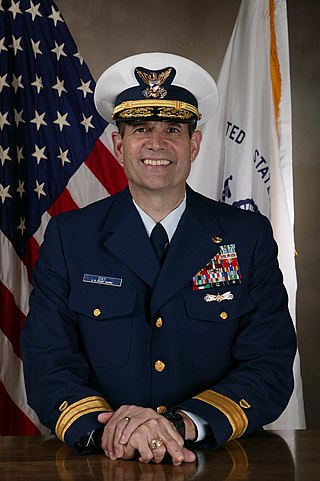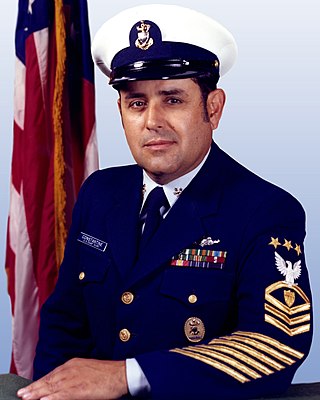The Commendation Medal is a mid-level United States military decoration presented for sustained acts of heroism or meritorious service. Each branch of the United States Armed Forces issues its own version of the Commendation Medal, with a fifth version existing for acts of joint military service performed under the Department of Defense.
Master chief petty officer (MCPO) is an enlisted rank in some navies. It is the ninth enlisted rank in the United States Navy and United States Coast Guard, just above Senior Chief Petty Officer (SCPO). Master chief petty officers are addressed as "Master Chief " in colloquial contexts. They constitute the top 1.25% of the enlisted members of the maritime forces.

The Coast Guard Distinguished Service Medal (CGDSM) is a military decoration of the United States Coast Guard that was established 4 August 1949 and is presented to coast guardsmen for "Exceptionally meritorious service to the government in a duty of great responsibility." Prior to this date, members of the Coast Guard were eligible to receive the Navy Distinguished Service Medal. The Homeland Security Distinguished Service Medal, which replaced the Transportation Distinguished Service Medal in 2002, is another higher precedence Distinguished Service Medal that may be awarded to Coast Guardsmen. The Coast Guard Distinguished Service Medal is equivalent to the Army's Army Distinguished Service Medal, Naval Service's Navy Distinguished Service Medal, and the Air and Space Forces' Air Force Distinguished Service Medal.

The Meritorious Service Medal (MSM) is a military award presented to members of the United States Armed Forces who distinguished themselves by outstanding meritorious achievement or service to the United States subsequent to January 16, 1969.
Awards and decorations of the United States government are civilian awards of the U.S. federal government which are typically issued for sustained meritorious service, in a civilian capacity, while serving in the U.S. federal government. Certain U.S. government awards may also be issued to military personnel of the United States Armed Forces and be worn in conjunction with awards and decorations of the United States military. In order of precedence, those U.S. non-military awards and decorations authorized for wear are worn after U.S. military personal decorations and unit awards and before U.S. military campaign and service awards.

Franklin A. Welch was the ninth Master Chief Petty Officer of the United States Coast Guard. Welch entered the Coast Guard in 1980 after graduating from Shades Valley High School Class of 1978, in Birmingham, Alabama. A former Master Chief Quartermaster, he served in office from October 10, 2002, to June 14, 2006, and served in the Coast Guard for over 26 years.

Terry D. Scott is a former United States Navy sailor who served as the 10th Master Chief Petty Officer of the Navy, from April 22, 2002, to July 10, 2006.
Norman Marous is a retired Chief master sergeant who served in the United States Armed Forces in various capacities, retiring as a member of the Vandenberg Air Force Base Ceremonial Honor Guard. With 41 years of service at the time of his retirement, Marous is the longest-serving non-commissioned officer on active service in the United States Air Force.

Jody A. Breckenridge is a former commander of the U.S. Coast Guard's Pacific Area.

Training Center Petaluma is a Coast Guard training facility in the northern California counties of Sonoma and Marin. Formerly the installation was the United States Army "Two Rock Station". Approximately 4,000 military students train there each year. It is the only Coast Guard training center or large installation without a major operational component or waterfront.

John C. Acton is a retired United States Coast Guard rear admiral who served as the Director of Operations Coordination for DHS. Acton formerly served as Director of the DHS Presidential Transition Team.
The United States Navy Senior Enlisted Academy provides education and training for senior and master chief petty officers. Most of the students are active-duty U.S. Navy personnel. The remaining students are from the Navy Reserve, Air Force, Army, Coast Guard, Marine Corps, and other nations' armed forces. https://www.public.navy.mil/netc/sea/Default.aspx

Steven E. Day is a United States Coast Guard rear admiral whose final duty assignment was Director of Reserve and leadership, (CG-13). In this role he commanded the United States Coast Guard Reserve. He previously served as the US deputy commander for mobilization and reserve affairs, Atlantic Area, US Coast Guard.

Michael Phillip Leavitt was the eleventh Master Chief Petty Officer of the Coast Guard (MCPOCG). He assumed the position from MCPOCG Charles W. Bowen on May 21, 2010 and was relieved on May 22, 2014, by Steven W. Cantrell. Leavitt was previously serving as the Senior Enlisted Advisor to the Deputy Commandant for Operations at Coast Guard Headquarters, Washington, DC.
Chief Petty Officer (CPO) is the seventh enlisted rank in the United States Navy and U.S. Coast Guard, just above Petty Officer First Class and below Senior Chief Petty Officer. The term "rating" is used to identify enlisted job specialties. In this way, enlisted personnel are segregated into three segments containing different enlisted ranks. Furthermore, rates are broken down into three levels: non-rated members without a designated occupation. Advancement to E-4 and above is dependent on graduating from a specialty school that define what the enlisted is rated for. Petty officers and chief petty officers are part of the rated force and considered extremely knowledgeable about their particular rating. Examples include Culinary Services Chief and Aviation Maintenance Chief. The Chief Petty Officer is the rank. Gunners Mate is a rating. E7 is a pay grade. The term rating is used to identify the career field of a chief petty officer. For example, the title of a chief petty officer in the Master-at-Arms rating would be spoken or spelled out as Master-at-Arms, Chief Petty Officer or Chief Master-at-Arms. The title would be abbreviated MAC. The grade of chief petty officer was established on 1 April 1893 in the United States Navy. The United States Congress first authorized the Coast Guard to use the promotion to Chief Petty Officer on 18 May 1920. Chief petty officer is also the final cadet grade in the United States Naval Sea Cadet Corps.

Allen William Thiele was the fifth Master Chief Petty Officer of the Coast Guard, serving from 1986 to 1990.

Carl Wayne Constantine was the fourth Master Chief Petty Officer of the Coast Guard, serving as the enlisted advisor to the Commandant of the Coast Guard, from 1981 to 1986.

Robert Jay Lloyd was the sixth Master Chief Petty Officer of the Coast Guard, serving as the enlisted advisor to the Commandant of the Coast Guard, from 1990 to 1994.
Charles E. Larkin is a retired United States Coast Guard vice admiral.













